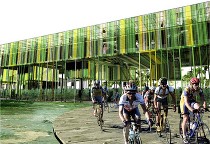
|
SocióPolis Project for a City of the Future Press conference: Wednesday, 27 October 2004, 11:00 am Opening: Wednesday, 27 October 2004, 07:00 pm Exhibition: 28 October - 31 January 2005 Opening Hours: daily 10.00 am - 07:00 pm, Wedn. 10:00 am - 09:00 pm Altered Opening Hours: 24 Dec., 31 Dec. 10:00 am - 04.00 pm PRESS RELEASE A unique and new city zone is arising on the periphery of Valencia, and under the optimistic title 'SocióPolis' it is having an exemplary effect on ideas for the future of the city offering quality of life with a hybrid urban structure. Barrier free residential zones for special target groups (senior citizens, families, children, youths, disabled persons), workplaces, recreational facilities, urban infrastructure and allotments are being linked to one another in the form of a micro-city. Fulfilling the three prerequisites of enabling social interaction, the linking of architecture with nature and the integration of new information technology in the living space, 12 internationally active teams of architects have, based on Vicente Guallart's master plan, formulated responses to the most pressing topics for current and future urban planning. MASTER PLAN The planning zone is situated on the periphery of Valencia in an area where the urban structures link up with the huertas – farming land for crop use. The master plan was developed on the basis of the idea behind medieval gardens in convent's and monasteries where fruit and vegetables and medicinal plants were grown for the community. In a new interpretation, a direct connection is being created between residential complexes and the integrated countryside. Each building has its own plot reserved for cultivating either fruit or vegetables at a prescribed density. The result has been a hybrid structure, an urbanisation of the garden or, vice-versa, an embedding of contemporary lifestyles and jobs in the countryside. The master plan does not contain any height limits or other such building restraints, although a unified colour scheme is specified to provide a connecting element for the diversity of architecture. Barrier-free, so handicapped-accessible, planning is a clear prerequisite for all areas. As a response to the hyper-speed of the globalised world, SocióPolis is an attempt to generate a Slow City, one distinguished by a high quality natural and developed setting. Accordingly, SocióPolis has been planned as a car-free city: an underground car park forms the point of intersection as a "speed-exchanger"; slightly raised, green paths enable one to move around the area on foot, by bicycle, electric car or similar. Under the motto 'My home is my neighbourhood, my neighbourhood is my home' tight-knit social relationships should develop in an experimental architecture that deploys the most modern materials and technology. Plurality and heterogeneity are foremost, the area is a successful composition of private and public space. THE PARTICIPATING TEAMS/THE FUNCTIONAL AGENDA The teams of architects invited to participate planned a multifunctional element in accordance with the brief, each with a living area for a specific social group/generation combined with infrastructure and service facilities: THE EXHIBITION The exhibition provides an overview of the planning zone and an introduction to the architects' designs, presenting a varied and high quality international range of current architectural tendencies. Portraits of the projects in the form of large-scale video projections show the complexity and heterogeneity of the individual elements. Interviews with the architects concerned provide answers to questions about the architecture, about nature, technology and social responsibility: "It will no longer make sense to speak specifically of social architecture as a type of architecture; all architecture will have to be social." Willy Müller Models of the projects provide a three-dimensional impression of the situation. PUBLICATION A comprehensive catalogue of the SocióPolis project is being published by ACTAR, Barcelona, to accompany the exhibition. Available in German/English and English/Spanish editions. 15cm x 21cm, approx. 240 pages with numerous full colour images. Project Manager: Vicente Guallart, Barcelona Coordination Az W: Kerstin Gust With the kind support of: Bienal de Valencia, Generalitat Valenciana |
 |
|
© Duncan Lewis |
|
Press page Current events Past events Gallery: Press images SocióPolis Dates: SocióPolis Information: Ines Purtauf Tel.: +43 (1) 522 31 15 - 25 Fax: +43 (1) 522 31 17 Email: purtauf@azw.at |
| © Architekturzentrum Wien 2024 |
||



